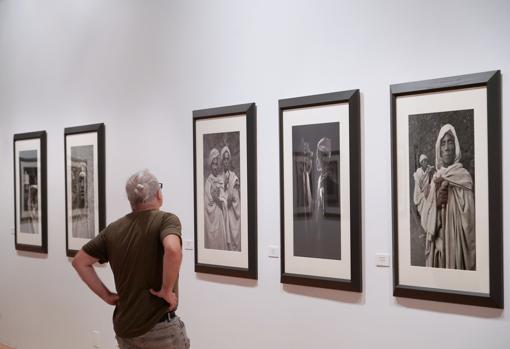VALLADOLID
Updated:
Save
The first time the photographer Cristina Garcia Rodero traveled to Ethiopia was in 2000. He did it to portray the Holy Week of the Orthodox Christians installed there, “it was very heartfelt, but not pretty.” In 2004 she returned, but did not see anything “interesting”. It was five years later, in 2009, “when I really worked.” She was then especially fascinated with Libela, a city located at 2,600 meters of altitude, in the heart of the mountains of the African country, converted into a sacred place and center of devotion for Ethiopian Christianity. The spirituality of this place, the beauty of ancestral rites handed down from generation to generation, is what he tries to reflect in ‘Lalibela, cerca del cielo’, the exhibition of the National Prize for Photography that from this Friday can be seen in the Municipal Hall of La Pasión in Valladolid.
It is part of the landing in the capital of Pisuerga of PhotoEspaña, the main photography festival held in our country, which also includes three other exhibitions inaugurated yesterday, with the works of the Italian Donna Ferrato, Ana Amado and the Indian Raghu Rai as protagonists.
The collected snapshots form part of the one that Cristina García Rodero recognizes as his most ambitious project to date, ‘Between heaven and earth’, still unfinished, where the Magnum photographer has endeavored to investigate concepts such as “spirituality and flesh, the religious and the pagan”, which has led her, she recalled this Friday in Valladolid, to explore remote places of the whole planet in which this religiosity is lived in a particularly intense way, from Ethiopia and India to Mexico «and many other countries»: «Wherever I go, I fall in love with the places».
As detailed by the curator of the exhibition, Oliva María Rubio, the work that now ends up in Valladolid after five years of traveling around the country is the product of a series of trips that the photographer made between 2004 and 2009. «There she was fascinated by Lalibela, a city that owes its current name to the king Gebre Mesqel Lalibela, who ruled in 1172 and 1212, who decided to create in it a new Jerusalem, a space of devotion, worship and pilgrimage for Ethiopian Christians. With that idea, she ordered the construction of eleven medieval churches carved into the rock, some fifteen meters deep, today converted into a center of pilgrimage and devotion for all Ethiopian Christianity.
This enclave, declared a World Heritage Site by UNESCO in 1978, serves as a setting for García Rodero to reflect the beauty of the rites that take place there annually to celebrate the epiphany, the baptism of Christ or his martyrdom and resurrection. “Many people go there to anoint themselves with holy water or to perform exorcisms, and Cristina captures all this thanks to her immense work and her ability to enter places without her presence being noticed” has also pointed out the Police station.

«I am very heavy working, I am never satisfied with what I do. The first time I went to Lalibela, in the year 2000, I went at Easter, but that was very heartfelt but not visually interesting. Then I came back in 2004 and divided myself into several spaces, and in 2009 was when I was able to really work. It’s monotonous, because it’s all prayers, prayers and masses that go on for several hours, but listening to them sing on top of the churches, with those cliffs of cut rocks, and seeing how they play music with small cymbals that they carry on their fingers… Just to see that it is already worth going there”, has detailed the photographer, for whom “Ethiopia is really worth it”.
García Rodero lamented the absence in Valladolid of his colleague at the Magnum Agency Raghu Rai, the Indian photographer whose works occupy the San Benito room in the exhibition ‘Mother India’, a retrospective in which the evolution of this country can be seen since its independence, 75 years ago, through the portrait of its women, but also of its diverse social, religious and ethnic conditions.
The spirituality of Ethiopia, through the eyes of Cristina García Rodero

